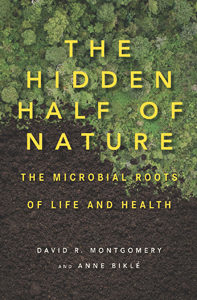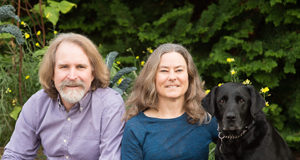An Interview with David Montgomery and Anne Biklé
[This article was previously published in the fall issue of The Cultivator, Cornucopia’s quarterly newsletter.]
by Jennifer Hayden, Ph.D
 |
W.W. Norton and Company |
What does soil health have to do with human health? A lot, it turns out. Healthy soil leads to a healthier environment, which improves health for everyone who lives near, or shares water with, farmland. And, healthy soil leads to healthier food, which improves health for those of us eating it!
But there’s more. When I recently sat down to talk with David Montgomery and Anne Biklé, authors of The Hidden Half of Nature: The Microbial Roots of Life and Health, they described an unseen world thriving in healthy soil that parallels the profusion of life inside our bodies.
They’ve carefully studied how biodiversity in the soil and in our guts are related. Their book on the topic is well worth a read by anyone interested in exploring the interconnection between soil health and human health. Here are some excerpts from our wide-ranging conversation.
Hayden: I’ve just finished reading The Hidden Half of Nature, and I was really excited about the parallels you draw between human health and soil health.
The journey you make in your own garden, with the intense composting and mulching, and the story of dealing with a cancer diagnosis and learning about gut health is fascinating.
The book brings together soil health and human health—through a deep dive into microbiota—in a way I’ve not seen before. So where did the seeds for this book idea germinate?
Biklé: Well, it’s interesting. We had always thought that the book would focus on soil and that we’d use our experience building a garden. We had both noticed, after about five years or so of me doing nonstop mulching of our garden, that it was changing the quality of the soil dramatically, and for the better.
Many soils, especially in the agricultural context, are quite depleted of carbon. We wanted to say, “Look, there’s this unappreciated and huge potential to store carbon in the soil through returning organic matter and it can help address climate change too.”
And then several things intersected: there was the release of debut papers on the human microbiome in Science and Nature, along with me dealing with a cancer diagnosis and having a lot of questions about the basis and foundation for health.
Montgomery: The whole direction of the book shifted when we started to realize, “Oh, there’s a bigger story here.” We started off talking about restoring soil. We ended up looking at the way beneficial microorganisms in the soil influence plant health, and then we came to see that our gut has a kind of inner soil that promotes our health.
Biklé: And now, after doing a lot of talks, we’ve got the book summarized in six words: “Mulch your soil, inside and out.” It applies equally well to the literal mulching of soil, as well as a metaphor for gut health.
Hayden: I think that a lot of us learned that it takes eons for the earth to generate top soil and that it can be destroyed really quickly. But what you found in your garden, and what modern agricultural research is finding, is that we can build healthy soil rapidly, and that’s exciting.
Montgomery: Yeah, it was astoundingly fast. In graduate school, Anne and I were also taught that it takes centuries to build an inch of topsoil. That’s a reasonable estimate of how long it takes nature to make it. But we were finding in our yard was that Anne had made a couple of inches of new topsoil in half a decade. So that made us think, “How is it possible for that to happen so fast?”
That led us to the role of microbial life in processing and decomposing and repurposing all the organic matter that we were adding as compost and mulch to the yard. That was our window into thinking about the microbial world.
The Hidden Half of Nature is an exploration of how microbial life can work to restore soil in your garden, on a farm, or inside of us. My new book, Growing a Revolution, looks at farmers around the world who have adopted practices that cultivate beneficial microbial life and how they’ve been able to restore fertility to their farms in years, not the centuries that you would think it would take.
Hayden: So if microbiota—all of the invisible life in the soil and in our digestive systems—are the key to health, how can we take care of them?
Biklé: What it really comes down to is microbiome-friendly practices for the soil and the body. If you focus on feeding the beneficial microbiota that live in the soil, or in the gut, it will go a long ways towards sustaining soil health or human health.
When farmers are transitioning from conventional to conservation, or organic, agriculture, there’s this two to three year period where the soil is getting fed all of this organic matter for the first time.
It’s jump-starting all of this microbial life that is kicking back into gear to do what it was always meant to do. After that transition period, soil health is well on its way to restoration.
I think about our bodies that way too. If you shift from a Western diet, or a heavily processed food diet, to one that feeds the microbiome ample amounts of the kinds of fodder that it needs to make medicinal compounds, your body too will go through a transition process. Getting the microbiome back on its proverbial feet is key to keeping you healthy.
That’s where I see the connections between soil health and human health lying, in that if we take care of the processes by adopting the right kinds of practices, we reap health. Health in the soil and health in the body.
 |
Anne Biklé is a biologist and environmental planner. Her career spans the fields of environmental stewardship, habitat restoration, and public health. The Hidden Half of Nature is her first book.
David R. Montgomery is a professor of geomorphology at the University of Washington, a MacArthur Fellow, and author of several books including the just released Growing a Revolution: Bringing our Soil Back to Life.

